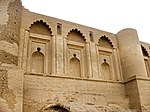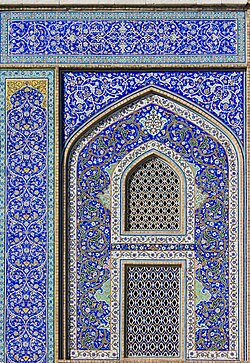Multifoil arch
A multifoil arch (or polyfoil arch), also known as a cusped arch,[1][2] polylobed arch,[3][4] or scallopped arch,[5] is an arch characterized by multiple circular or leaf shapes (called foils, lobes, or cusps) that are cut into its interior profile.[2][1][6] The term foil comes from the old French word for "leaf." A specific number of foils is indicated by a prefix: trefoil (three), quatrefoil (four), cinquefoil (five), sexfoil (six), octofoil (eight), or multifoil and polyfoil for typically more than eight.[7][8] The multifoil arch is characteristic of Islamic art and architecture; particularly in the Moorish architecture of al-Andalus (Iberian Peninsula) and North Africa and in Mughal architecture of the Indian subcontinent.[9] Variants of the multifoil arch, such as the trefoil arch, are also common in other architectural traditions such as Gothic architecture.[2]: 132
Origins[]
The first multifoil arches were developed by the Umayyads and can be found in a small mosque at Qasr al-Hallabat, one of the Umayyad Desert Castles, in present-day Jordan.[10][11] The architects of this structure experimented with both hollow/concave lobes and protruding/convex lobes in the relieving arches above the doors.[12]: 513-514 Multifoil arches also appear early on as decorative niches in the Qasr al-'Ashiq in Samarra, present-day Iraq, and in the Mosque of Ibn Tulun in Cairo, Egypt, both of which were built under Abbasid (and Tulunid) rule in the 9th century.[1][13][14]: 87 These examples have been used to support the hypothesis that multifoil arches originated in the Middle Eastern regions of the Islamic world, although Richard Ettinghausen and Oleg Grabar have called this hypothesis into question.[14]: 87-89 [12]: 513
Other early examples of multifoil arches are found in the Great Mosque of Cordoba in al-Andalus (present-day Spain), in particular the arches of the maqsura area added to the mosque in the 10th century by al-Hakam II.[15]: 232–234 Ettinghausen and Grabar argue that the form of these arches probably developed locally in al-Andalus, noting that in Cordoba they occurred as structural elements while in the eastern Islamic world they occurred mostly as decorative elements.[14]: 87-89 Another scholar, Ignacio Arce, notes that Ettinghausen and Grabar did not take into account the earlier occurrences at the Qasr al-Hallabat mosque, where polylobed arches are used as structural elements.[12]: 513-514 Jonathan Bloom also argues that the intersecting cusped arches of the Great Mosque of Cordoba were a local development, likely the result of a deliberate elaboration from the older two-tiered round arches that were part of the mosque since its initial foundation in 785.[16]: 72
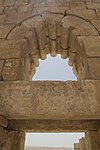
Polylobed arch (with convex or protruding lobes) at Qasr al-Hallabat, Jordan (7th–8th century)
Decorative niches with polylobed arches at Qasr al-'Ashiq in Samarra, Iraq (9th century)

Intersecting multifoil arches in the Great Mosque (present-day cathedral) of Cordoba, Spain (10th century)
Later developments[]
Islamic world[]
The typical multifoil arches that appear in later buildings of Al-Andalus and North Africa also have precedents in Fatimid architecture in Ifriqiya and Egypt, for example at Bab Zuweila (dated to 1091). Georges Marçais argued that both the Great Mosque of Cordoba and Fatimid architecture in Ifriqiya were probably the most relevant precedents which led to the adoption and development of multifoil arches in the western regions of the Islamic world.[15]: 232–234 Multifoil arches appear prominently in the 11th-century Aljaferia palace of the Taifas period in al-Andalus. In the Almoravid and Almohad periods (11th–13th centuries), this type of arch was further refined for decorative functions while horseshoe arches continued to be standard elsewhere.[15]: 232–234 They appear, for example, in the Great Mosque of Tlemcen (in present-day Algeria) and the Mosque of Tinmal (present-day Morocco).[15]: 232 The motif of intersecting multifoil arches also gave rise to the sebka motif which is frequently employed in the art and architecture of the region.[15]: 257–258 In Egypt, the cusped trefoil or trilobed arch became a characteristic decorative feature of portals in late Fatimid architecture and Mamluk architecture (from approximately the 12th to 16th centuries).[17]: 191 [18]: 89 Later on, multifoil arches also became a characteristic feature of Mughal architecture on the Indian subcontinent during the 17th century.[19][20]: 1062 [21]

Interlacing multifoil arches at the Alcazaba of Malaga in Spain (11th century)
Blind polylobed arch at the Fatimid gate of Bab Zuweila, Cairo, Egypt (1087–1092)[22]

Blind interlacing multifoil arches on the Almohad minaret of the Kutubiyya Mosque in Marrakesh, Morocco (12th century)
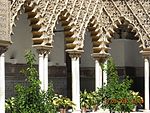
Multifoil arches in the Mudéjar Patio de las Doncellas at the Alcazar of Seville in Spain (14th century)

Trilobed (trefoil) arch in the entrance portal of the Khanqah-Mausoleum of Sultan Barsbay in Cairo (completed in 1432)

Multifoil arches in the Agra Fort, India (17th century)
Christian Europe[]
In the architecture of Christian Europe, multifoil arches appear occasionally in Romanesque architecture, with some early examples in France such as the chapel of Saint-Michel-d’Aiguilhe in Le Puy-en-Velay, France (10th–11th century) and the Abbey of Cluny (circa 1100).[1][23]: 272 In the Christian territories of the Iberian Peninsula (present-day Spain), the earliest examples are from the early 12th century and found in the Collegiate Church of San Isidoro in Léon and the Cathedral of Santiago de Compostela.[23]: 272 These early Iberian examples were highly similar to the multifoil arches of contemporary Islamic/Moorish architecture in al-Andalus and were probably directly appropriated from the latter.[24]: 105–107 [23]: 272 Scholars Francine Giese and Sarah Keller argue that this initial appropriation from Muslim architecture was likely intended to express a sense of triumph and superiority over Islamic al-Andalus at the time, but that over the course of the 12th century the motif became acculturated to Romanesque art and then developed independently from al-Andalus in both Christian Iberia and France.[23]: 272 As a result, multifoil arches became more common and developed multiple variations in the Romanesque architecture of these regions during the later 12th century.[24]: 105–107 [23]: 272 In Toledo, after its conquest by Castile in 1085, the new churches and synagogues which were built in the 12th century and after were designed in a Mudéjar style that frequently incorporated polylobed arches as part of its visual repertoire.[23]: 273 The Cathedral of Toledo, whose construction began in the 13th century, was built primarily in a Gothic style but also incorporates polylobed arches (most notably in the triforium of the ambulatory), suggesting that this motif had by then become thoroughly assimilated to local Christian architecture.[23] Multifoil arches, particularly trefoil arches, became common in Gothic architecture for portals and decoration throughout Europe.[2] Cusped forms (not necessarily as arches) were also common to form the motifs used in Gothic tracery.[1]
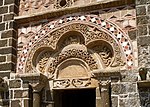
Blind polylobed above the door of the Romanesque chapel of Saint-Michel-d’Aiguilhe in Le Puy-en-Velay, France (10th–11th century)
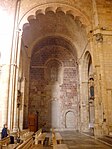
Multifoil arch in the Church of San Isidoro in Léon, Spain (early 13th century)
Multifoil arch decoration on the Mudéjar bell tower of the Church of Santo Tomé in Toledo, Spain (14th century)

Decorated multifoil/trefoil portal in the Capelas Imperfeitas of the Batalha Monastery, Portugal (circa 1435)
See also[]
References[]
- ^ a b c d e "cusp | architecture | Britannica". www.britannica.com. Retrieved 2021-11-19.
- ^ a b c d Hourihane, Colum (2012). The Grove Encyclopedia of Medieval Art and Architecture. Vol. 2. Oxford University Press. ISBN 978-0-19-539536-5.
- ^ "Qantara - Fragment of wood ornamented with arches". www.qantara-med.org. Retrieved 2020-09-11.
- ^ Llorente, Margarita Sánchez. "Arch". Discover Islamic Art - Virtual Museum. Retrieved 2020-09-11.
- ^ Ragette, Friedrich (2003). Traditional Domestic Architecture of the Arab Region. Edition Axel Menges. p. 37. ISBN 978-3-932565-30-4.
- ^ Society, National Geographic (2012-09-14). "Cusped Arches". National Geographic Society. Retrieved 2021-11-19.
- ^ "Polyfoil", Webster's Dictionary (1913). Retrieved 14 May 2019
- ^ Buffaloah-multifoil arches. Retrieved 21 November 2011
- ^ Lookuparchitecture: Moorish arches Archived 2012-04-04 at the Wayback Machine. Retrieved 21 November 2011
- ^ Alexander Sarantis, Enrico Zanini, Luke Lavan. (2008). Technology in Transition A.D. 300-650, Brill, p. 513.
- ^ Diana Darke. (2020). Stealing from the Saracens: How Islamic Architecture Shaped Europe, Hurst, p. 166.
- ^ a b c Arce, Ignacio (2008). "Umayyad Building Techniques and the Merging of Roman-Byzantine and Partho-Sassanian Traditions: Continuity and Change". In Lavan, Luke; Zanini, Enrico; Sarantis, Alexander (eds.). Technology in Transition A.D. 300-650. Brill. pp. 491–538. ISBN 978-90-474-3304-0.
- ^ Petersen, Andrew (1996). "arch". Dictionary of Islamic architecture. Routledge. pp. 24–25. ISBN 9781134613663.
- ^ a b c Ettinghausen, Richard; Grabar, Oleg; Jenkins, Marilyn (2001). Islamic Art and Architecture: 650–1250 (2nd ed.). Yale University Press. ISBN 9780300088670.
- ^ a b c d e Marçais, Georges (1954). L'architecture musulmane d'Occident. Paris: Arts et métiers graphiques.
- ^ Bloom, Jonathan M. (2020). Architecture of the Islamic West: North Africa and the Iberian Peninsula, 700-1800. Yale University Press. ISBN 9780300218701.
- ^ Graves, Margaret S. (2018-07-31). Arts of Allusion: Object, Ornament, and Architecture in Medieval Islam. Oxford University Press. ISBN 978-0-19-069592-7.
- ^ Behrens-Abouseif, Doris (2007). Cairo of the Mamluks: A History of Architecture and its Culture. The American University in Cairo Press. ISBN 9789774160776.
- ^ M. Bloom, Jonathan; S. Blair, Sheila, eds. (2009). "Architecture; VII. c. 1500–c. 1900; D. India". The Grove Encyclopedia of Islamic Art and Architecture. Oxford University Press. ISBN 9780195309911.
- ^ Dadlani, Chanchal; Sharma, Yuthika (2017). "Beyond the Taj Mahal: Late Mughal Visual Culture". In Flood, Finbarr Barry; Necipoğlu, Gülru (eds.). A Companion to Islamic Art and Architecture. Wiley Blackwell. pp. 1055–1081. ISBN 9781119068662.
- ^ Nath, R. (2006). "Monuments: Mughal". In Wolpert, Stanley A. (ed.). Encyclopedia of India: Vol. 3. Thomson Gale. pp. 156–165. ISBN 978-0-684-31352-8.
- ^ "Qantara - Gates of Bāb al-Nasr, Bāb al-Futūh, and Bāb al-Zuwayla". www.qantara-med.org. Retrieved 2021-11-19.
- ^ a b c d e f g Giese, Francine; Keller, Sarah (2021). "The Limits of Otherness: Decoding the Entangled Heritage of Medieval Iberia". In Giese, Francine (ed.). Mudejarismo and Moorish Revival in Europe: Cultural Negotiations and Artistic Translations in the Middle Ages and 19th-century Historicism. Brill. pp. 269–279. ISBN 978-90-04-44858-2.
- ^ a b Martin, Therese (2006). Queen as King: Politics and Architectural Propaganda in Twelfth-Century Spain. Brill. ISBN 978-90-474-1851-1.
External links[]
![]() Media related to Multifoil arches at Wikimedia Commons
Media related to Multifoil arches at Wikimedia Commons
- Islamic architectural elements
- Moorish architecture
- Islamic architecture
- Architecture of Spain
- Architectural elements
- Architectural element stubs
- Al-Andalus stubs


